Green spiders are common in parks, gardens, and woodlands all across the world.
These small green arachnids use their camouflage green color to avoid detection by small insects such as mosquitoes.
Green spiders don’t typically spin spider webs. They ambush predators by using waiting for preying techniques instead.
Some green spiders can have a uniform green color while many have a mostly green body with a contrasting colored abdomen.
Table of Contents
Are Green Spider Venomous or Poisonous?
Most green spiders aren’t venomous. These spiders can be mildly-venomous at times, however.
Mildly venomous green spiders aren’t dangerous to human health but they can bite painfully.
Some reports show painful bites of mildly venomous green spiders lead to local skin irritations such as edema with a diameter of up to a few inches.
Most green spiders aren’t dangerous or venomous. They prefer not to bite people as many eat only a certain type of insect such as mosquitoes.
30 Types of Green Spiders
The following species of green spiders are highly common. Many live on green leaves to make the most of their camouflage coloring.
1. Green Lynx Spider
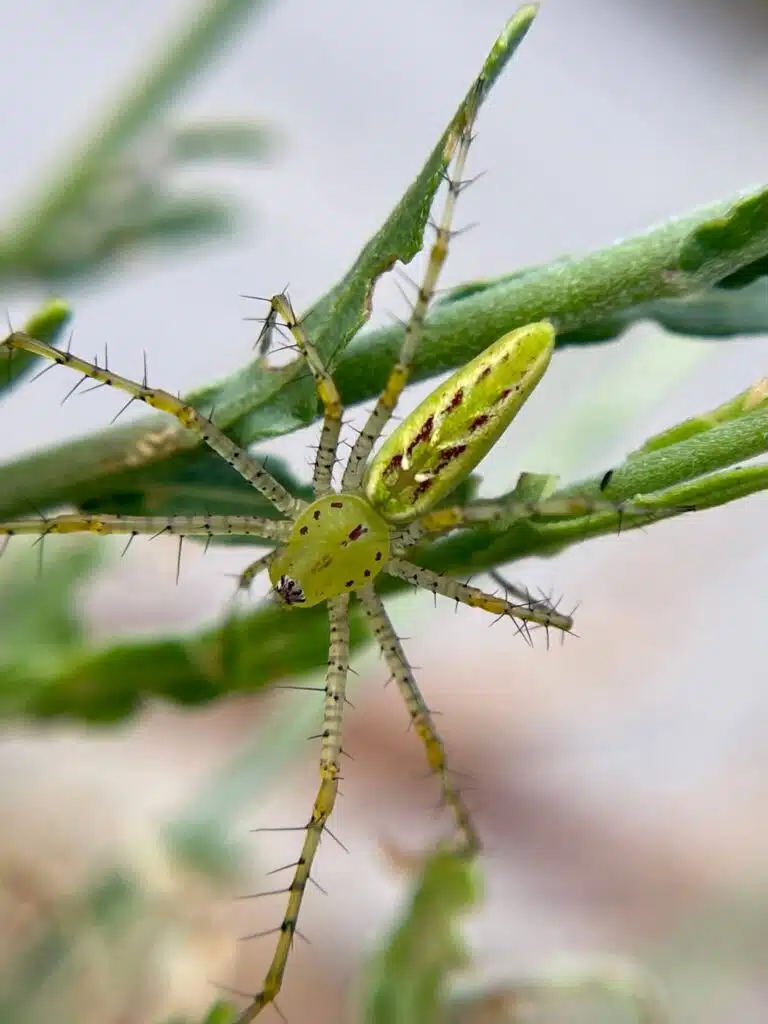
Scientific name: Peucetia viridans
Common name: Green lynx spider
The Green Lynx spider is a species characterized by its almost uniform green body.
Spiders of this genus have yellow chevron-shaped marks on their abdomen but their main color is green.
Even the legs of the species are pale green with short bristle-like black hairs.
Female Green Lynx spiders grow to a size of 22mm while males grow to a size of up to 12mm.
Farmers see Green Lynx spiders as beneficial.
This family of spiders eats most types of invasive crop moths.
Bollworm moths are often controlled by introducing predatory species such as Green Lynx spiders.
2. Magnolia Green Jumping Spider
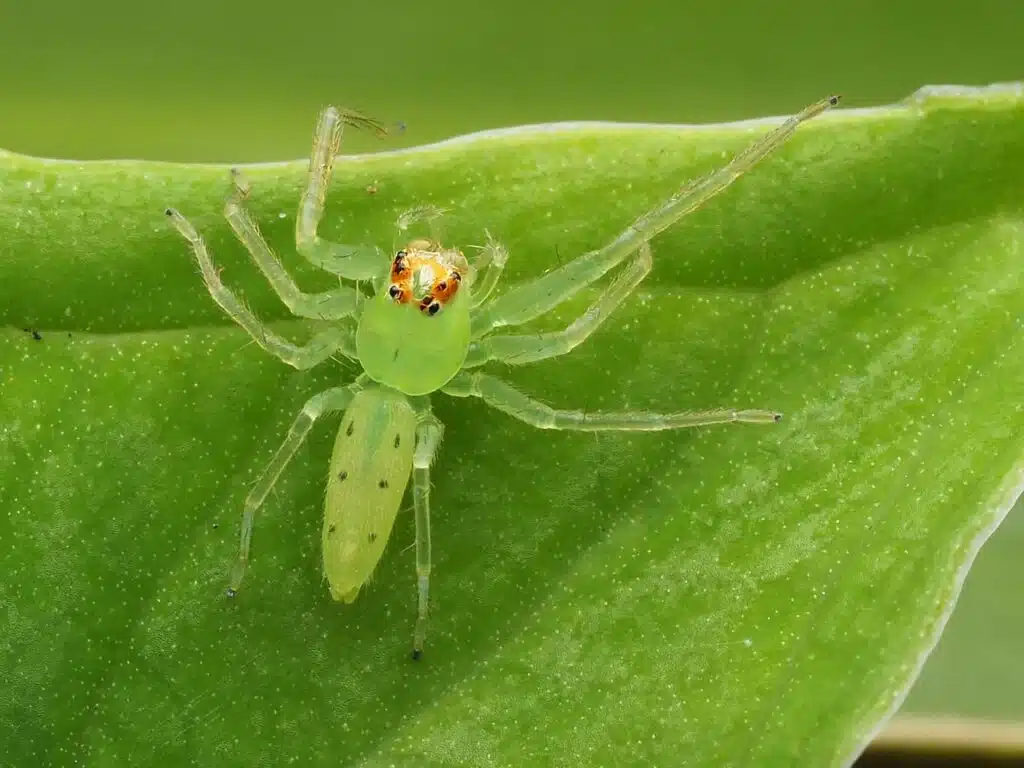
Scientific name: Lyssomanes viridis
Common name: Magnolia green jumping spider, magnolia green jumper
Magnolia Green Jumping spiders are known for their almost transparent body.
These spiders have a pale green to yellow color, green legs, and a green-yellow abdomen.
2 rows of black spots are distinguished on the abdomen.
As their name implies, the spiders are most common on magnolia trees. They are less common in woodlands such as oak woodlands or mixed hardwood woodlands.
These spiders are ambush predators.
They rely on very good vision to jump on prey. While they produce silk, they do not spin spider webs.
Female Magnolia Green Jumping spiders only wrap the eggs they lay in silk.
These eggs are found on the underside of magnolia tree leaves.
3. American Green Crab Spider
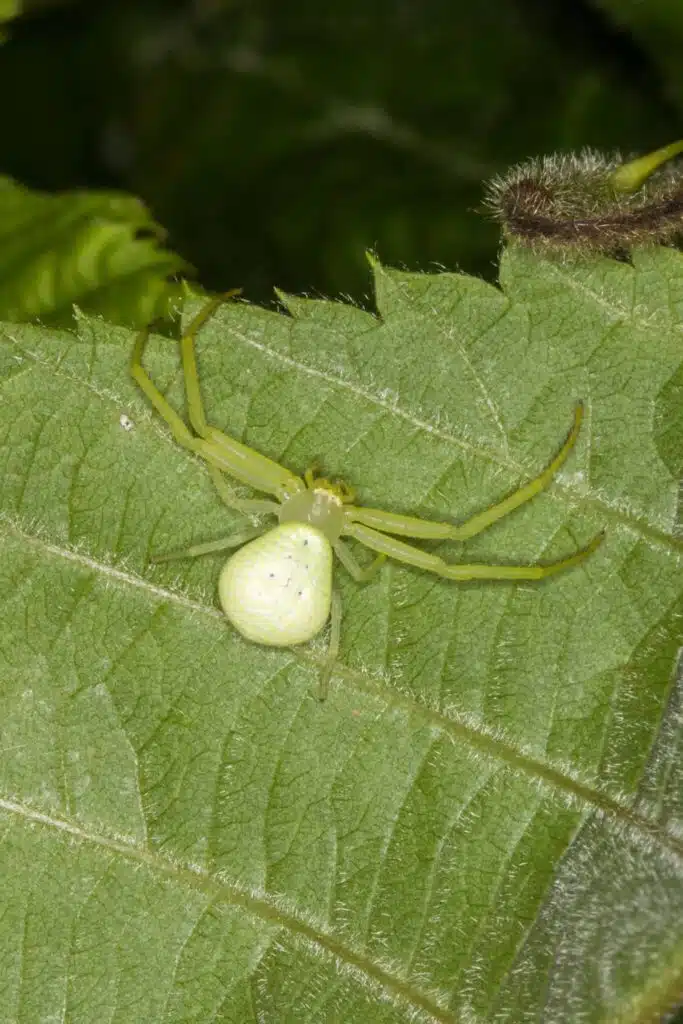
Scientific name: Misumessus oblongus
Common name: American green crab spider
The American Green Crab spider gets its name from its vivid green color. This species has an orange arrow-shaped mark on the abdomen.
The abdomen of the American Green Crab spider seems perforated upon close inspection.
Spiders of this genus are part of a group that can move similarly to crabs, as their name implies.
These spiders can move sideways and even back as crabs do.
American Green Crab spiders don’t spin spider webs.
They prefer to climb green vegetation looking for prey. Their green coloring acts as camouflage making them almost invisible to insect prey.
Females of the species lay an egg sack soon after mating.
This egg sack is typically attached to vegetation but it may also be found low on the ground or hidden in a curled leaf.
4. Cucumber Green Spider
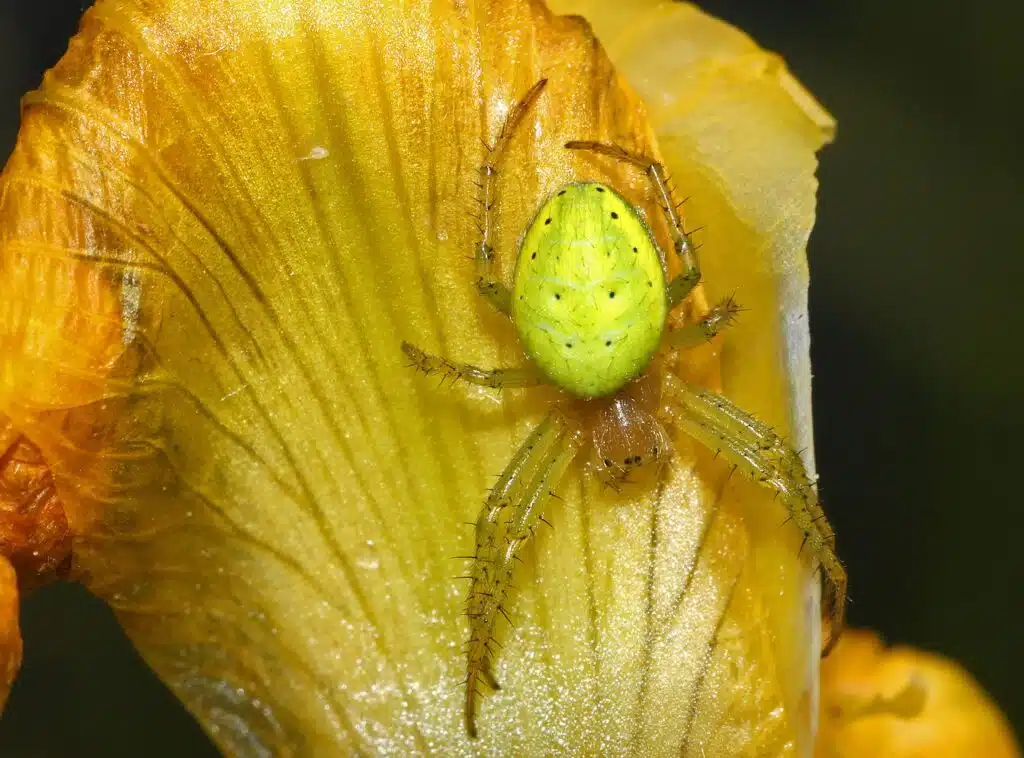
Scientific name: Araniella cucurbitina
Common name: Cucumber green spider
Cucumber Green spiders are a common sight in the Northern Hemisphere. These spiders grow to a size between 4 and 9.5mm.
They are characterized by a green body. The cephalothorax has a green-brown color while the legs and the abdomen are bright green.
A few small black spots are also visible on the abdomen of these spiders.
The ventral side of the species has black and yellow marks on the abdomen.
Cucumber Green spiders build large spider webs they are seen on most times. This web is repaired every night for new insects the following day.
Spiders of this genus prefer to build this spider web in green leaf flowers and vegetables such as cucumbers.
This is where their green color acts as camouflage to make them more difficult to detect.
5. Triangle Crab Spider
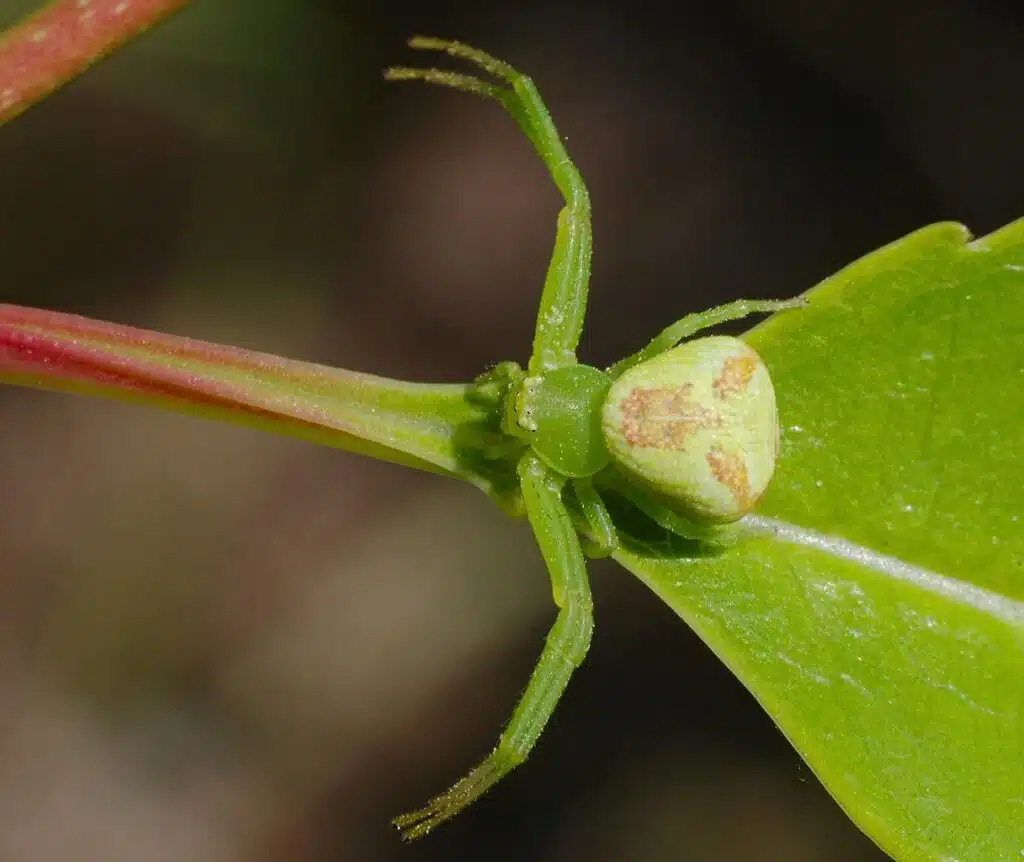
Scientific name: Ebrechtella tricuspidata
Common name: Triangle crab spider
The Triangle Crab spider gets its name from its resemblance to crabs. Its legs are positioned more like crab legs than spider legs.
This species has distinct coloring between male and female spiders.
Females are dominated by green coloring on the cephalothorax and the legs with green-yellow coloring on the abdomen.
Male spiders have a crude green abdomen with white marks, brown legs, and a brown cephalothorax.
Known for their short lifespan, these spiders are only seen from May to June in the case of males and from May to September in the case of females.
Both males and females are small compared to other North American spiders. Males grow to a size between 2.5 and 3.5mm.
6. Green Huntsman Spider
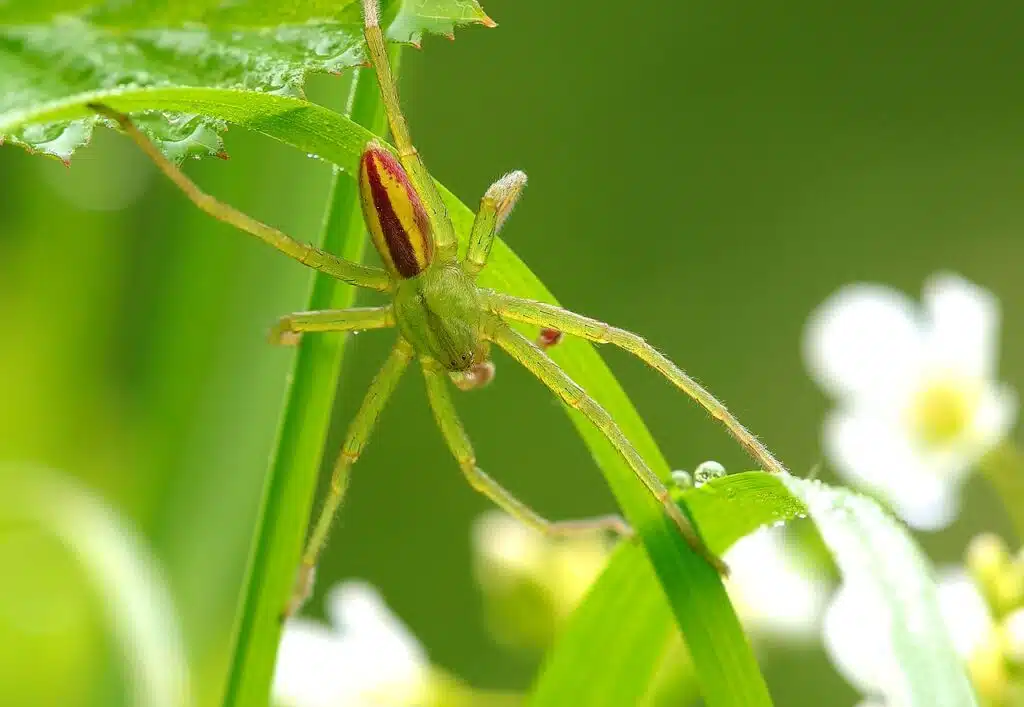
Scientific name: Micrommata virescens
Common name: Green huntsman spider
The Green Hunstman spider is one of the most common green spiders in Northern Europe.
This species has small differences in green nuances between males and females.
Female Green Huntsman spiders have a uniform green color.
Males have a darker green color with a yellow-green abdomen.
Both males and females also have bright green legs.
Green Huntsman spiders get their name from their predatory behavior. These spiders don’t build spider webs.
They make the most of their camouflage green color to prey on various insects in thick green vegetation.
7. Eurasian Green Crab Spider
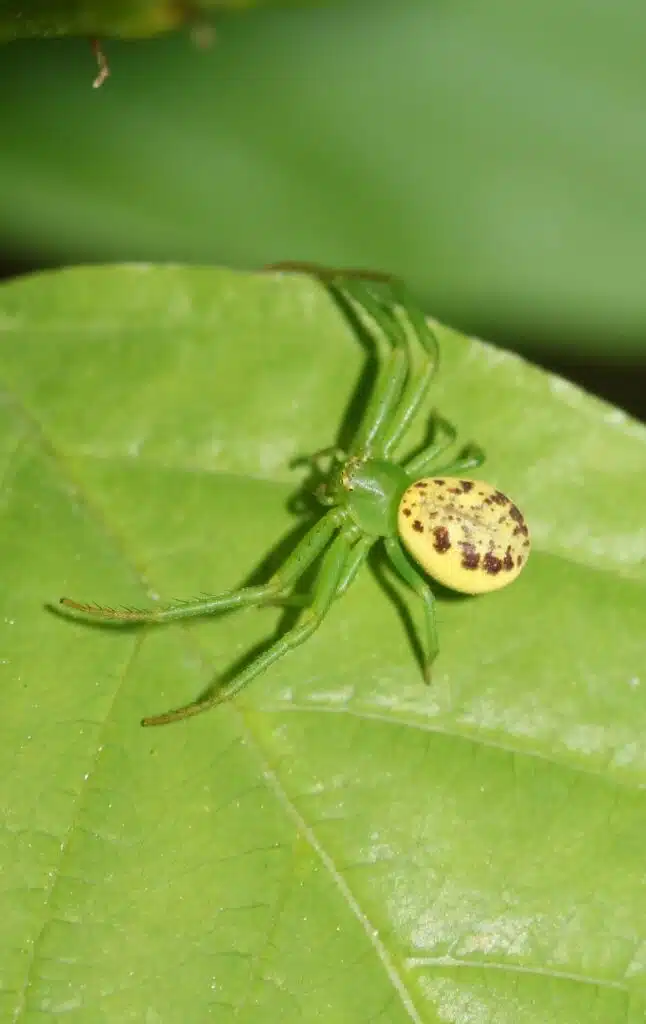
Scientific name: Diaea dorsata
Common name: Eurasian green crab spider
Eurasian Green Crab spiders are known for their partially-green body.
These spiders have green cephalothorax and green legs with short white bristle-like hairs.
The dome-shaped abdomen is yellow with brown marks on the female and green-yellow on males.
Spiders of this genus also have yellow marks around the eyes.
This color isn’t the final version of green an adult Eurasian Green Crab spider is known for.
This species can also change its green nuance completely.
This capacity can take takes to achieve but the Eurasian Green Crab spider can enhance its camouflage capacity by adjusting its coloring to its surroundings.
Male adults of the species can be seen up to mid-summer while females live longer sometimes surviving to mid-fall.
8. Micrommata ligurina
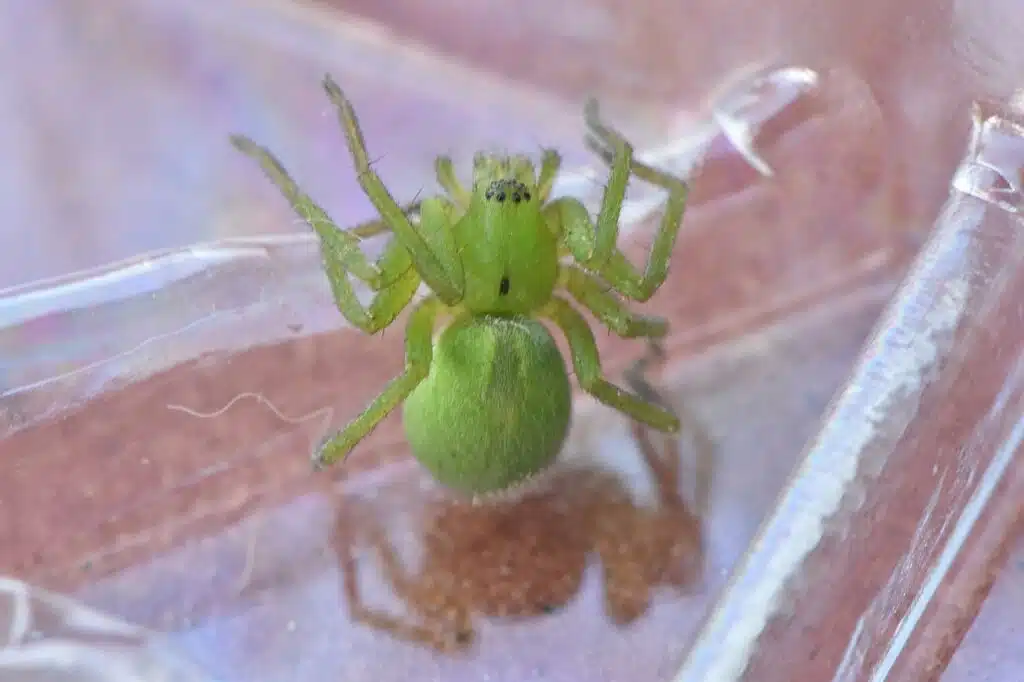
Scientific name: Micrommata ligurina
Common name: Micrommata ligurina
This spider genus is characterized by a green body and green legs.
It exhibits multiple shades of green and short white hairs across the legs with short black hairs along its body.
This spider has a dark green cephalothorax and a pale green abdomen with fewer black hairs.
The abdomen of the species is dome-shaped and it represents almost all of its body. This genus of spiders is common in thick vegetation in Europe and Northwest Africa.
Spiders of this genus are known to grow to 8mmm but most individuals only grow to a size of 2.5-4mm.
9. Green Jumping Spider
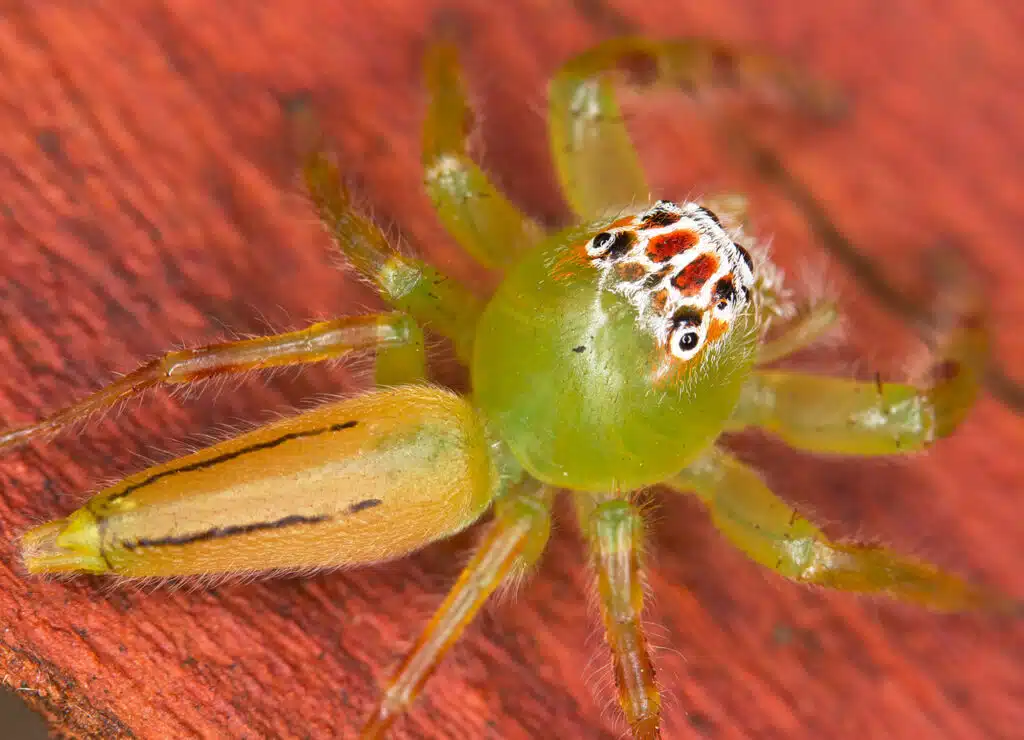
Scientific name: Mopsus mormon
Common name: Green jumping spider
Green Jumping spiders are characterized by vivid green coloring.
The green color of these spiders with the ability to jump is almost uniform. Males exhibit brown patches on their legs alongside a base green coloring.
Comparing the male and the female spider coloring is only possible during the mating season as these spiders are solitary.
Female Green Jumping spiders mostly start mating when males enter their nests.
In some cases, female Green Jumping spiders can also mate outside of the nest, mainly by getting to choose which male spider to mate with.
10. Green Meshweaver
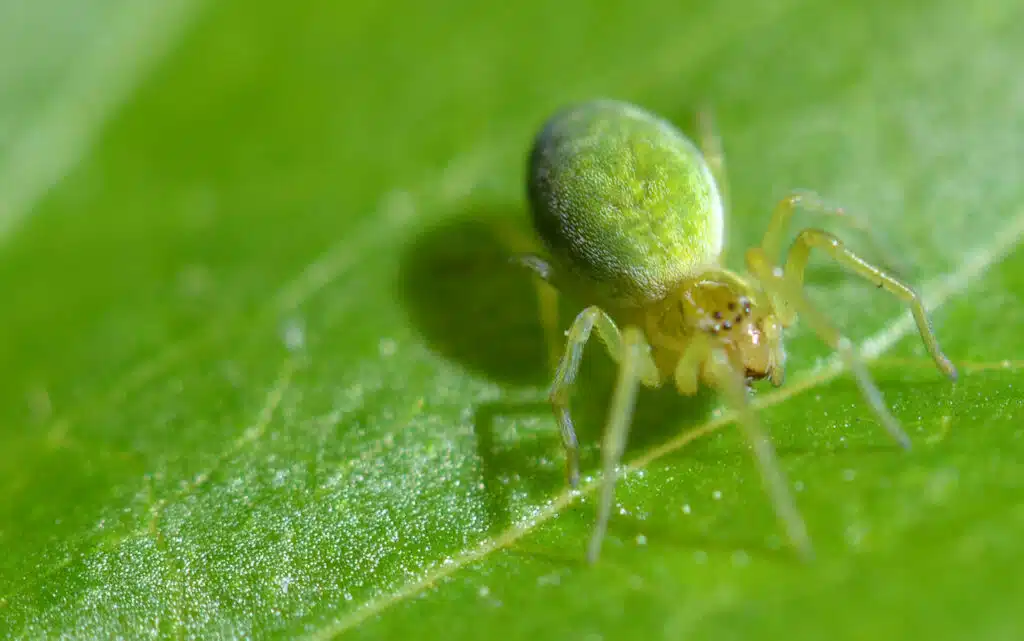
Scientific name: Nigma walckenaeri
Common name: Green meshweaver
Green Meshweaver spiders are common in gardens and some private parks.
These spiders are known for eating moths and for their vivid green coloring.
Color differences between males and females are small. Both have vivid green coloring and yellow Chevron-like marks on the abdomen.
The legs of these spiders are also green, but not as dark as the green color of the rest of the body.
While not very efficient at building spider webs, Green Meshweavers are still capable of building small webs to hide in.
Most of these webs are found in decorative garden flowers and bushes such as ivy.
The spiders are mostly seen in the spring and the summer.
11. Lesser Green Lynx Spider
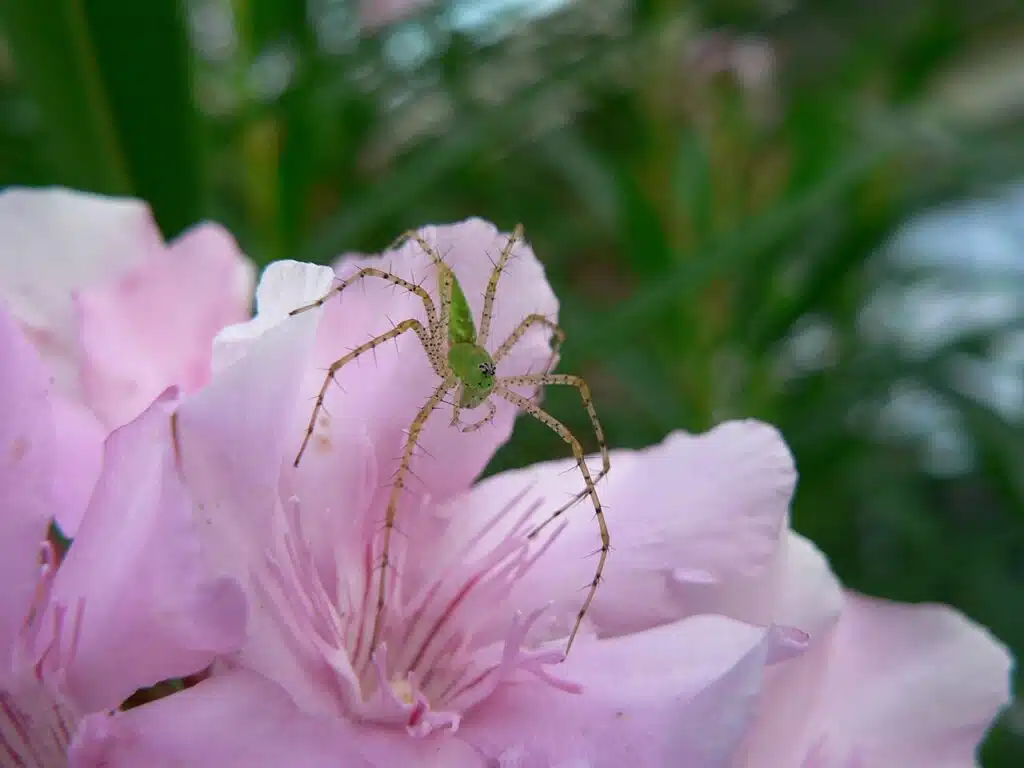
Scientific name: Peucetia longipalpis
Common name: Lesser green lynx spider
The Lesser Green Lynx spider is one of the most common green spiders in Southern US states.
It’s the most common green spider in shrub plants in Florida.
This genus of spiders is characterized by a green cephalothorax and green legs. It has a yellow abdomen in the case of the females and a green abdomen with yellow stripes in the case of males.
Spiders of this genus are mostly seen in open fields where shrub-like flowers grow.
They can also populate gardens where these flowers are grown.
While sometimes found in suburban areas, the spider isn’t aggressive or known to bite.
12. Speckled Orbweaver
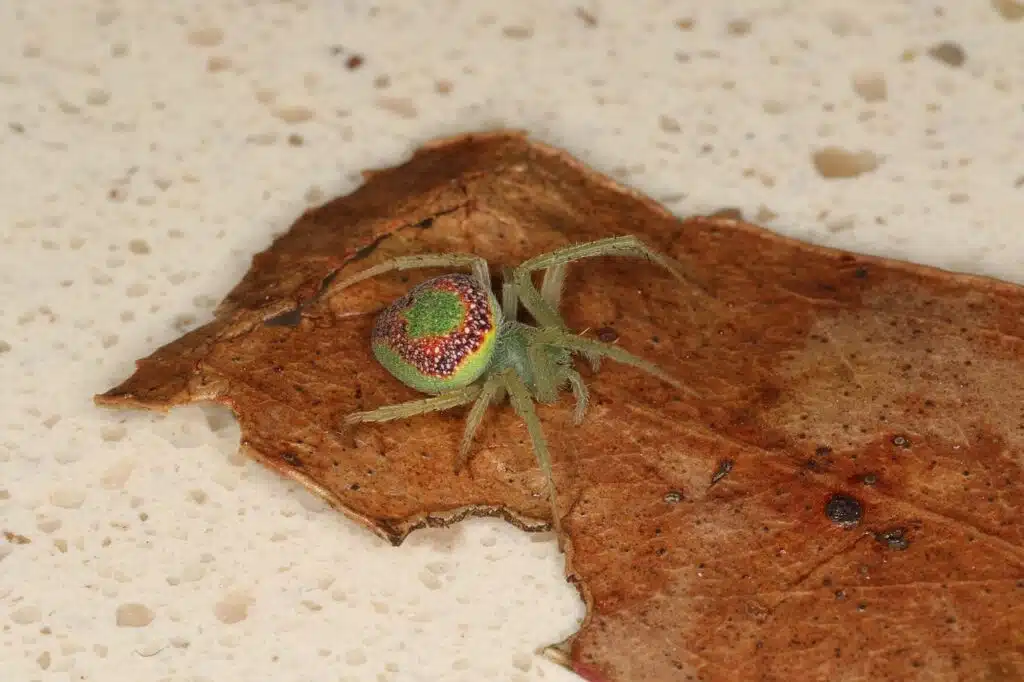
Scientific name: Araneus circulissparsus
Common name: Speckled orbweaver
Speckled Orbweavers are common green spiders in thick vegetation.
This species grows to a size of up to 4.5mm and can have a few variations, all based on a green color.
Its cephalothorax is green, as are the legs and as is the abdomen.
Spiders of this genus can have 2 eye-like brown and yellow marks on each side of the abdomen.
These marks are sometimes joined by a line.
Another common morph of the species has a brown abdomen with green and yellow marks.
All of these morphs are adaptations of the Speckled Orbweaver to its leafy green environment which improve its camouflage.
13. Slender Green Orbweaver
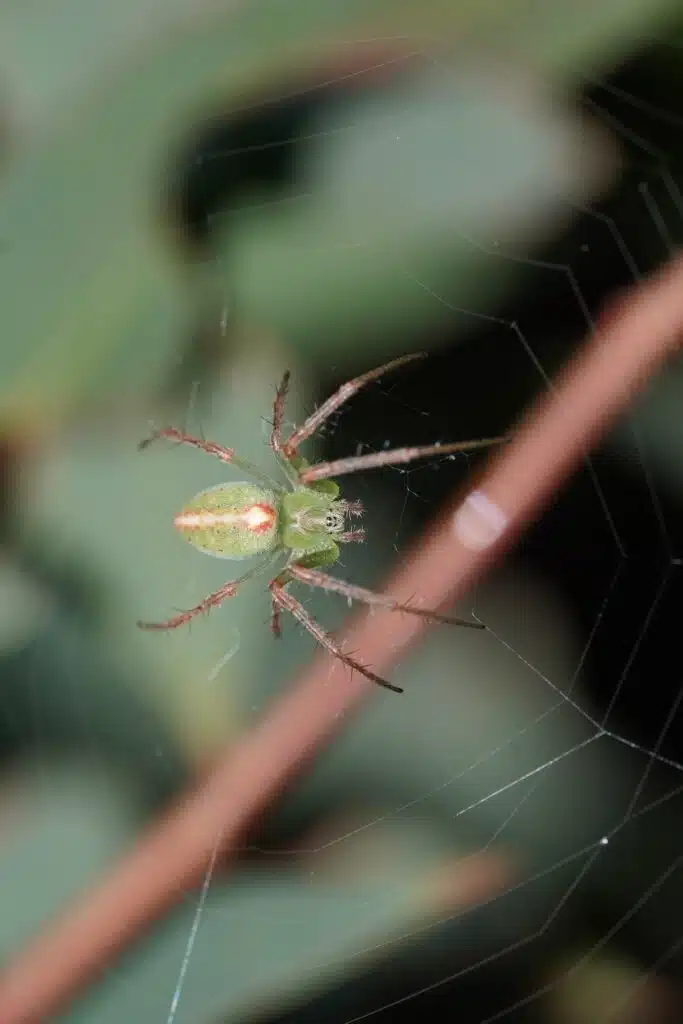
Scientific name: Araneus talipedatus
Common name: Slender green orbweaver
The Slender Green Orbweaver is a common spider species that also has green coloring.
Green is the base color of the female which has a green abdomen, green legs, and a green cephalothorax.
These spiders also have a white central line on the abdomen bordered by 2 red lines.
Male spiders can also exhibit red coloration on the abdomen but in the form of connected dots rather than in the form of parallel lines bordering a white central stripe.
Some morphs of this genus also have a yellow abdomen with red lines on the sides and red marks on the legs.
Spiders of this genus are mostly tied to eucalyptus where they hide all day.
14. Lozenge-shaped Crab Spider
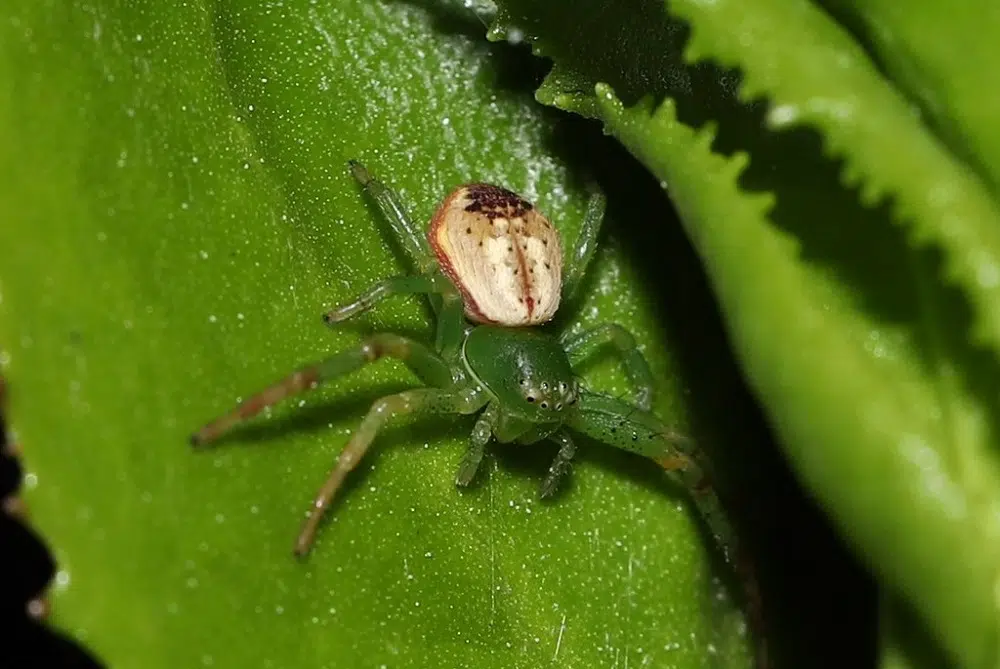
Scientific name: Australomisidia pilula
Common name: Lozenge-shaped crab spider
This spider family is known to be mostly green.
Common in Australia, the spider species is dominated by a green cephalothorax and a brown-red abdomen with white lines along its body.
Its legs are also dark red.
Males and females can exhibit small color variations.
Females tend to have lighter colors on the abdomen which can sometimes be yellow and not brown-red as in the coloring of the males’ abdomen.
Female spiders are also known to have red-brown marks in the central section of the abdomen when the base color is yellow.
Some of these spiders have all-green legs while others have green and brown legs.
These are environmental adaptations as the spider tries to mimic its host plant so that it improves its camouflage.
15. Long-jawed Orbweaver
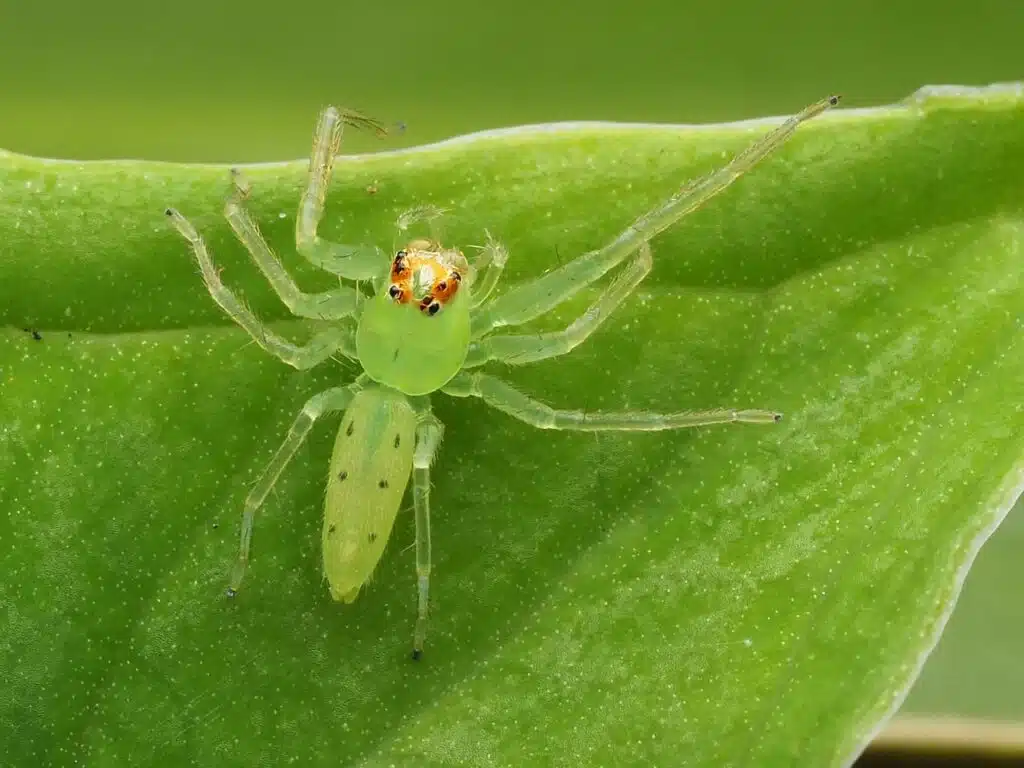
Scientific name: Tetragnatha viridis
Common name: Long-jawed orbweaver
This small green spider is an orbweaver common in pine or fir forests.
It has elongated mouth parts it can use to bite people. The species isn’t venomous or aggressive.
Spiders of this genus have elongated legs with short black hairs and yellow to red elongated mouthparts.
The cephalothorax is green and the abdomen is only green on the lower part as it’s also yellow and brown on the top side of the abdomen with white lateral lines.
Known for having 2 rows of eyes, this species doesn’t have very good vision.
It relies on its capacity to sense spider web vibrations to detect potential insects to feed on.
Some color variations of the species have been reported. Rare golden color abdomen spiders of the species are sometimes found on fir.
16. Green Orbweb Spider
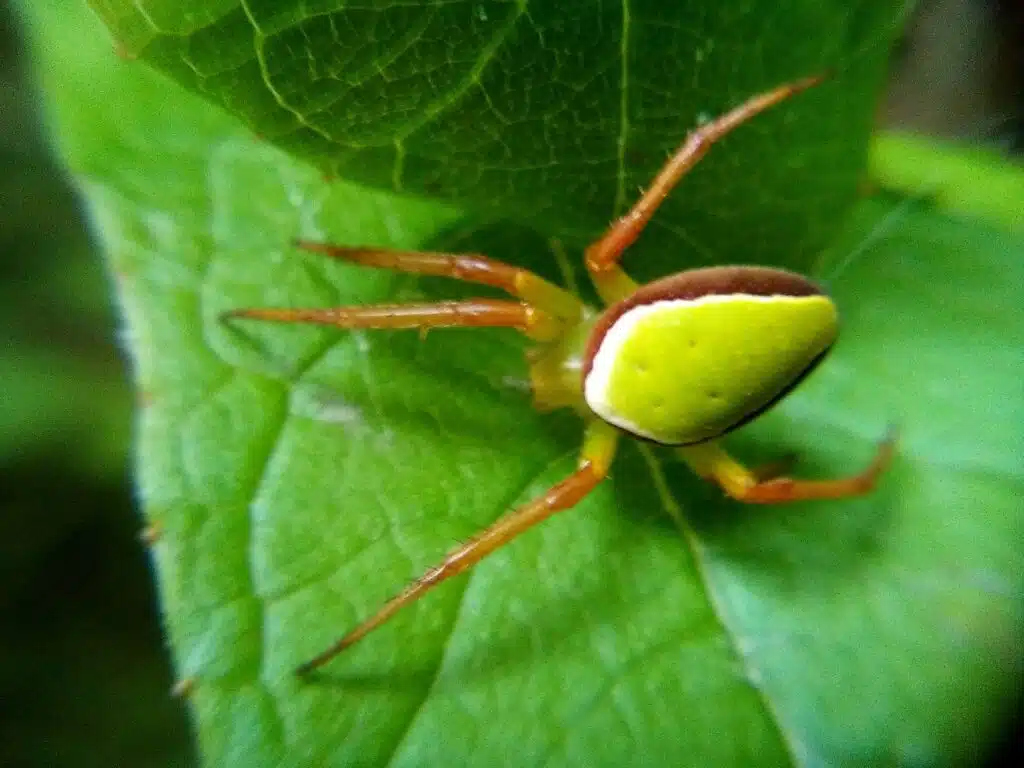
Scientific name: Colaranea viriditas
Common name: Green orbweb spider
Green Orbweb spiders are common in gardens. Found in many areas around the world, this species has spread with the import of flowers.
Green Orbwev spiders are common in different colors. All of its variations include a significant percentage of green coloring about the body.
Its most common morph is a translucent green cephalothorax and legs with a bright green abdomen bordered by white lines.
Another common version of this spider only has a green abdomen but has red legs and a red cephalothorax.
A combination of these morphs is also seen in some gardens. A green spider with red legs, a green cephalothorax, and a green abdomen with yellow marks are also common.
These spiders are seen sitting on spider webs all day.
They hang upside-down waiting for insects to get caught in their spider webs.
Even if they have 8 eyes on 2 rows, these spiders lack good vision and need to feel the insects on the spider web before moving in to kill them.
17. Spotted Orbweaver
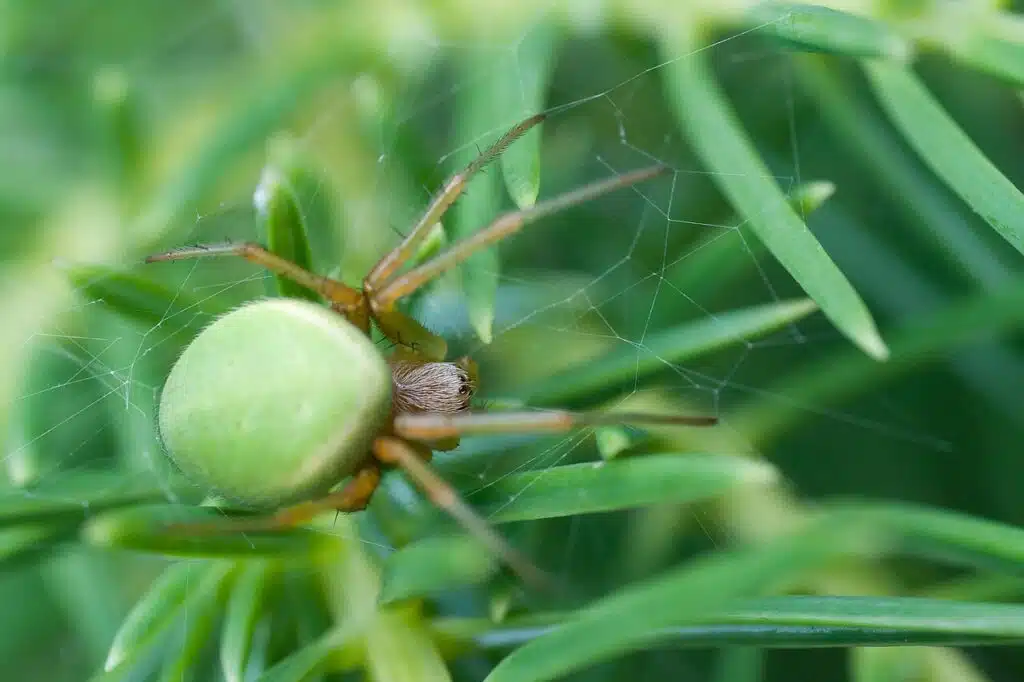
Scientific name: Neoscona scylloides
Common name: Spotted orbweaver
Also known as the Barn spider, the Spotted Orbweaver is a common species across the world.
It lives in North America, Europe, and parts of Asia including Japan.
Spotted Orbweavers are found in different colors. Most of them are based on a green abdomen which may or may not come with yellow stripes along the edges.
The abdomen can also have brown or yellow spots.
The cephalothorax can be brown or green. Spiders of this genus can have green, brown, or black legs.
Spotted Orbwevaers have a long pair of first legs.
Common in gardens, the green Spotted Orbweaver is seen along with man-made buildings, especially on farms as they attract many insects.
18. Red-spotted Orbweaver
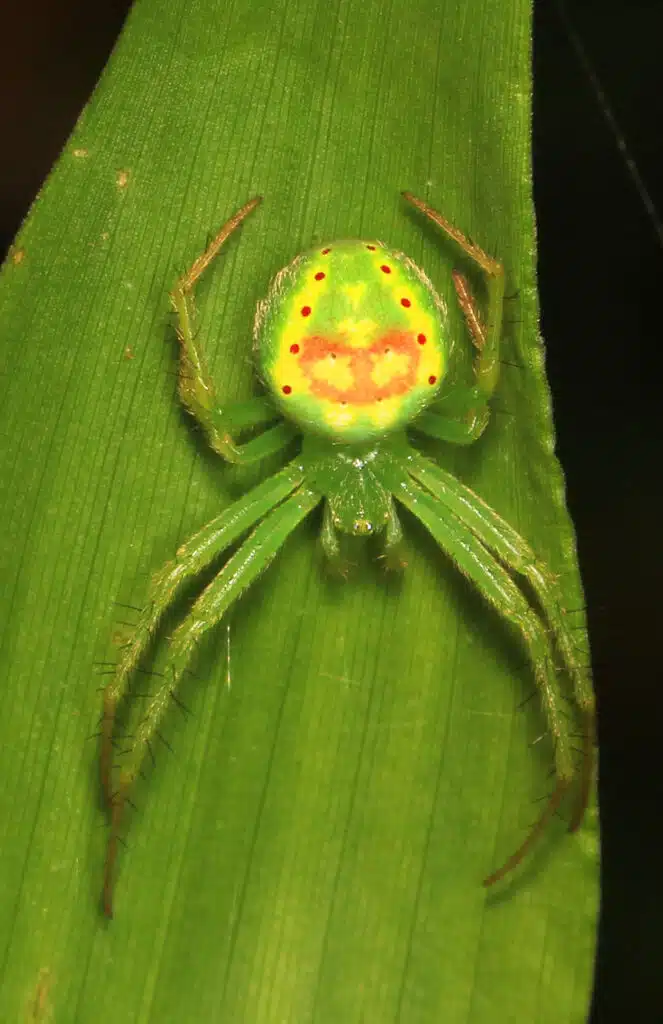
Scientific name: Araneus cingulatus
Common name: Red-spotted orbweaver
Red-spotted Orbweavers get their name from the red spots on the green abdomen. This spider species is mostly green.
It has a light green cephalothorax and a dark green abdomen with red dots, and parallel white and yellow lines.
Red-spotted Orbweavers have green legs with long black hairs.
This coloring allows the species to improve its camouflage-like abilities.
Red-spotted Orbweavers are commonly found in trees where they may be difficult to spot based on their green color.
These spiders are commonly found on trees in gardens and can be seen as they are active during the day.
The Red-spotted Orbweaver is an imported species from Europe.
19. Elongate Green Crab Spider
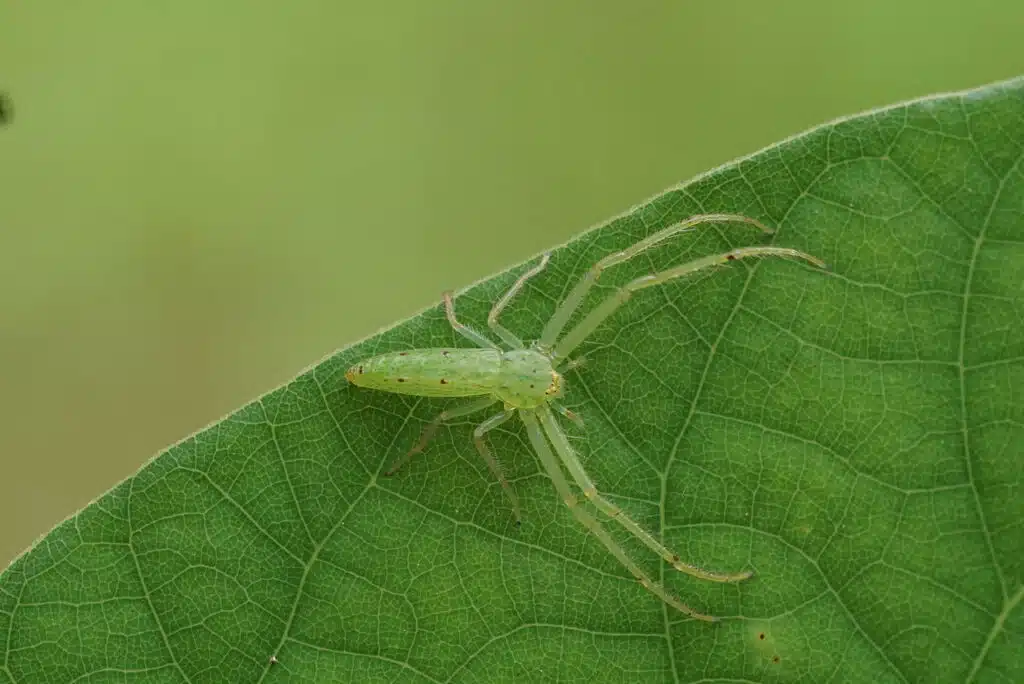
Scientific name: Oxytate virens
Common name: Elongate green crab spider
The Elongate Green Crab Spider is known for its uniform green color.
Spiders of this species have elongated front legs and short rear legs.
They have an almost transparent green color and a single yellow mark on top of the head.
Most of these spiders are found in Southeast Asia as native species. They are also introduced to Eastern US.
This species can be difficult to identify as the spider doesn’t resemble crabs apart from having elongated front legs.
However, it might resemble crabs more than other similar green spiders native to India.
Spiders of this genus are mostly seen on trees hiding in plain sight on green leaves.
20. Red-tipped Crab Spider
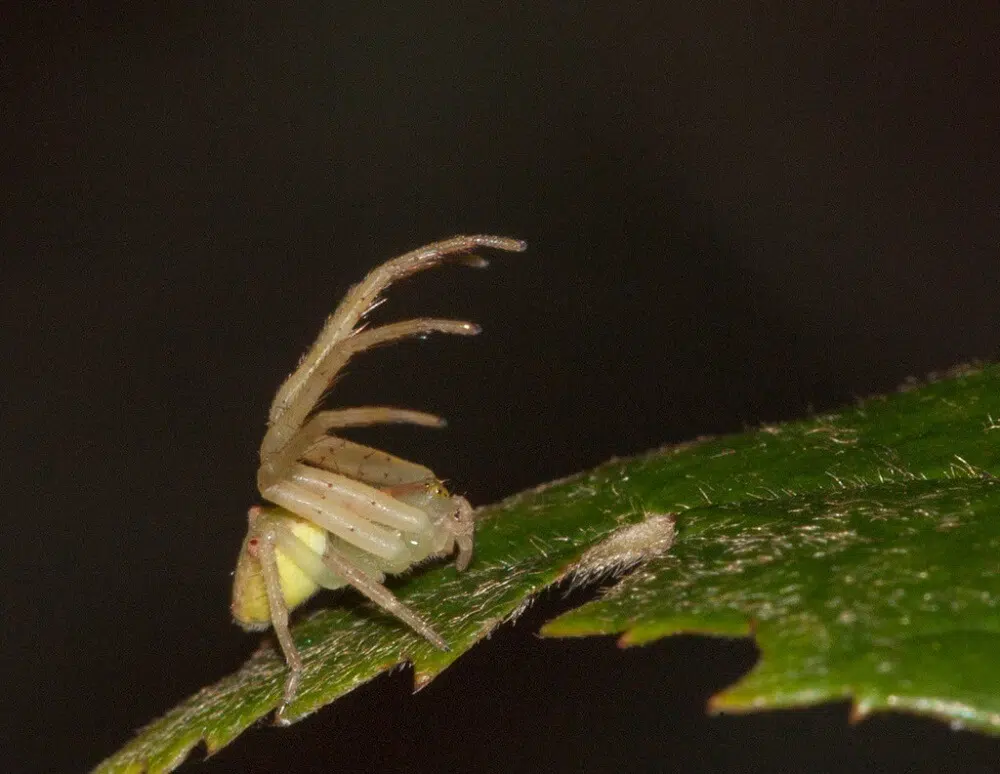
Scientific name: Sidymella rubrosignata
Common name: Red-tipped crab spider
Red-tipped Crab spiders are native to Australia but increasingly common around the world.
These spiders spread through the flower trade as they’re often found on Dianella flowers. This is a type of flower Australia and New Zealand export.
The red-tipped Crab spider is mostly green and only occasionally red.
Its body has uniform green coloring with green legs.
The abdomen has a brighter green-yellow color compared to the green color of the legs and the cephalothorax.
Spiders of this genus do not spin webs. They sit on Dianella flowers waiting for various insects to come to them.
The insects need to be close to these spiders for them to attack. As crab spiders, they can move sideways and backward easier than common spiders.
As part of a larger group of spiders, the Red-tipped Crab spider can also have different colors in other parts of the world.
It takes on a red color or even a brown color on Dianella flowers in Southeast Asia.
21. Epeus glorius
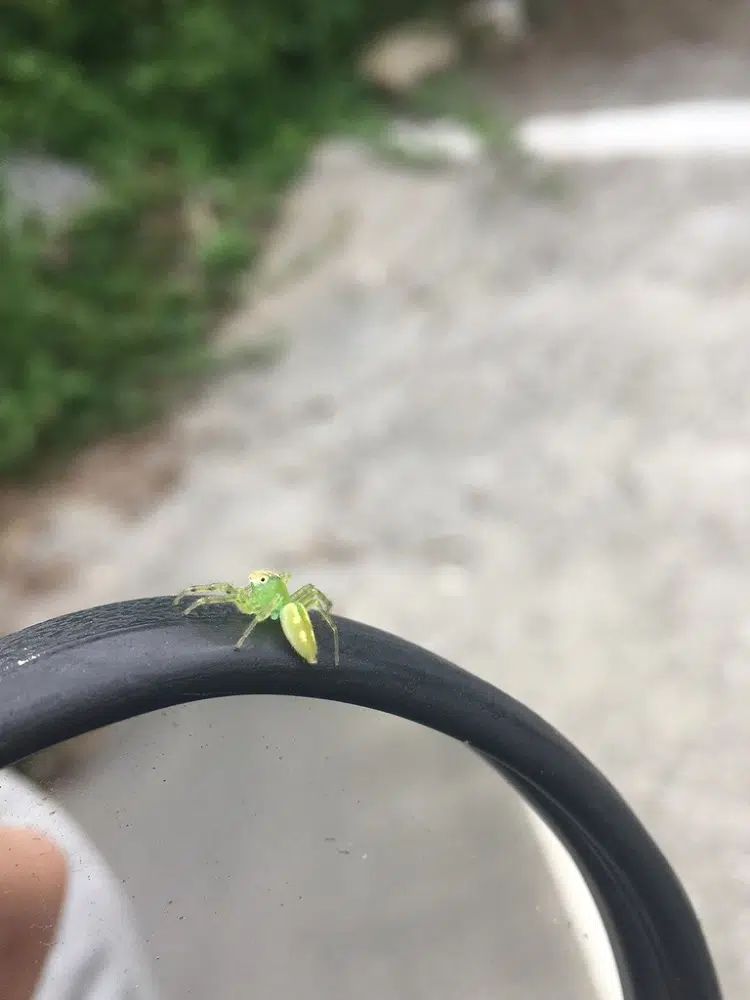
Scientific name: Epeus glorius
Common name: Epeus glorius
Part of the Epeus group of spiders, this species is mostly found in Japan and nearby regions of China.
This is a type of spider that lives on flowers and that takes on the green color of flower leaves.
Epeus spiders have a green color with various brown and white marks
along the body or the legs.
Epeus glorius is no different but it only has brown and white marks on its cephalothorax as opposed to Epeus flavobilineatus and other spiders of this genus.
These spiders sit on flowers waiting for prey to come to them. Insects drinking flower nectar are their prey.
This spider genus can further be distinguished by having similar-length 3 pairs of front legs.
These legs have short white hairs as opposed to whiter and black hairs as other Epeus spiders.
22. Indian Green Lynx Spider
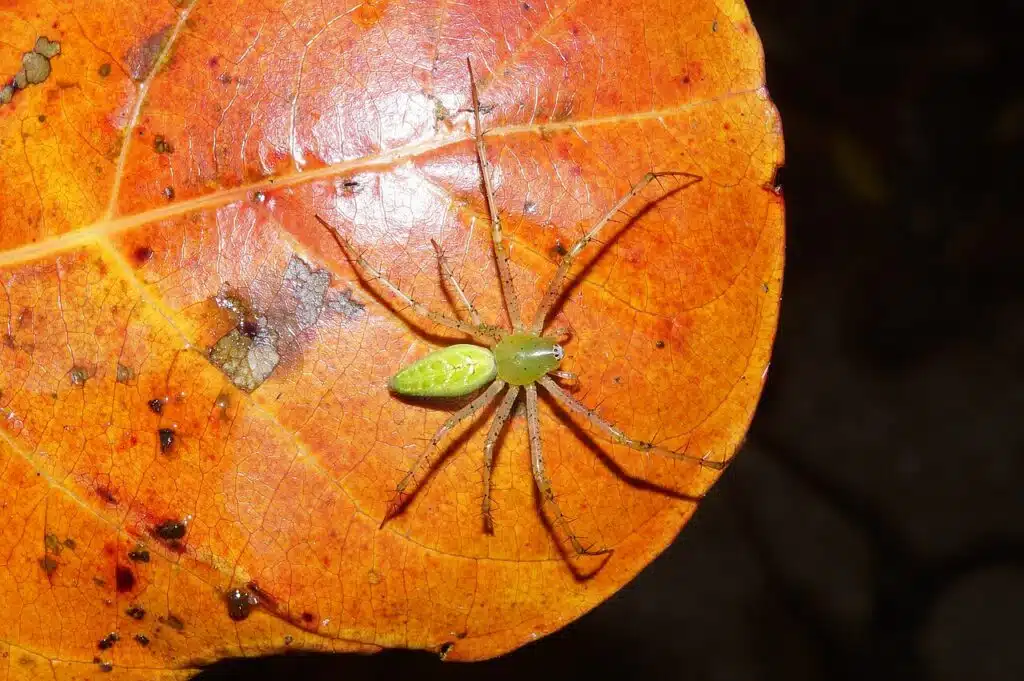
Scientific name: Peucetia viridana
Common name: Indian green lynx spider
The Indian Green Lynx spider is known for its green body with yellow stripes.
Spiders of this genus are used on cotton fields as they can control certain species of moths.
Incoming moths do not see these spiders as their green camouflage color makes them barely visible.
Indian Green Lynx spiders have varying sizes with a maximum body length of 22mm.
Spiders of this genus are beneficial to agriculture but they are known to bite.
While not venomous, their bite can still trigger allergic reactions. The mild venom of the species has been shown to come with mild bite symptoms such as edema.
Large edemas of up to 22 inches have been reported following the bite of the Indian Green Lynx spider.
23. Northern Lined Hygropoda
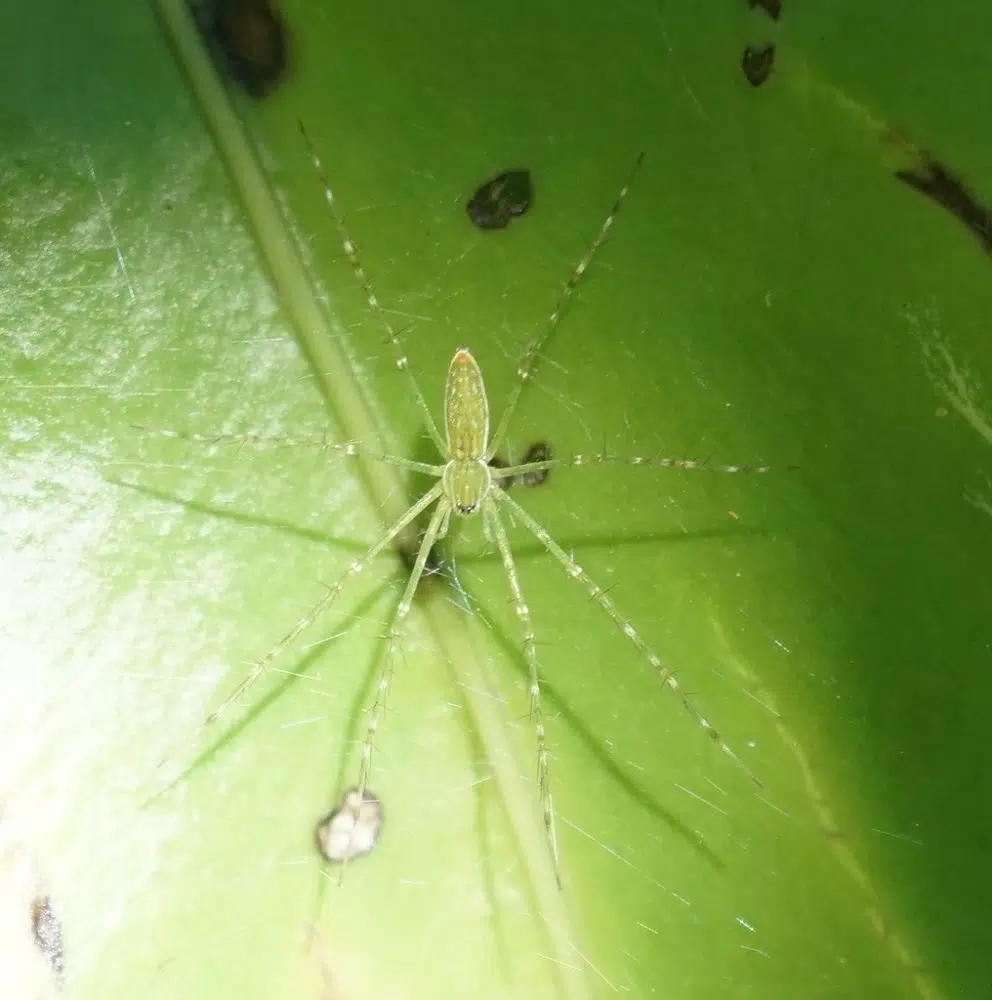
Scientific name: Hygropoda lineata
Common name: Northern lined hygropoda
Northern Lined Hygropoda spiders are a common sight next to water sources in Australia.
This species grows to an average size of 11mm and it’s known for having different colors of the sexes.
Males are brown while females have a green body with stripes.
The white vertical stripes are seen all across its body.
These spiders have similarly-colored green legs with black hairs.
Northern Lined Hygropodas is a species of spider that lives on green leaves. They prefer upturned green leaves which allow them to build a small spider web inside.
Since the spiders live next to water they are bound to consume insects found next to water sources such as mosquitoes.
24. Tailed Jumper
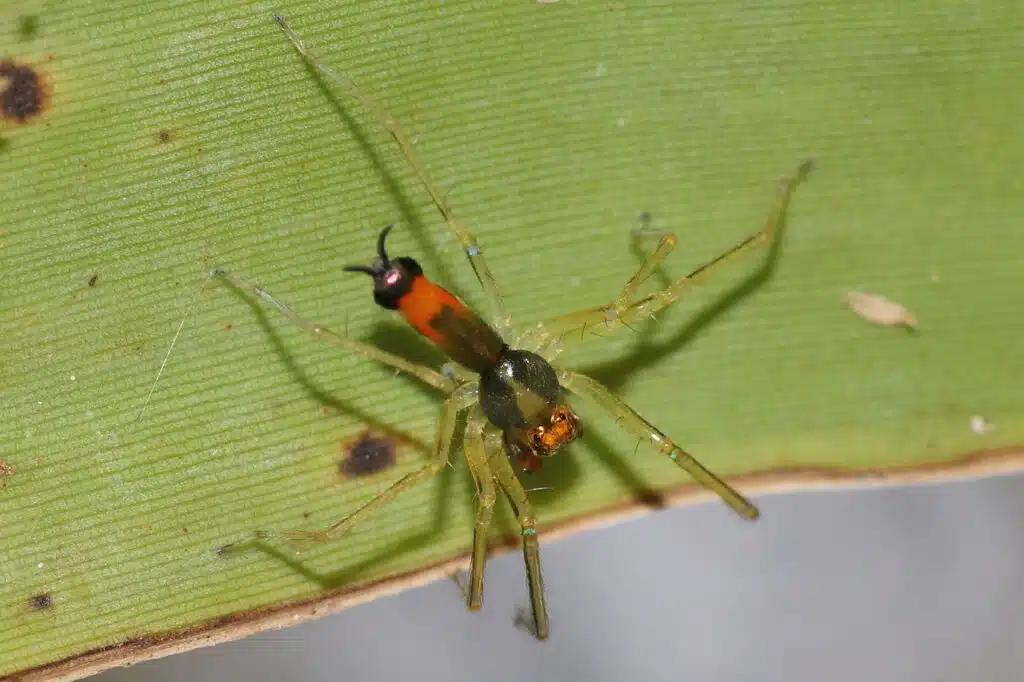
Scientific name: Asemonea tenuipes
Common name: Tailed jumper
This small spider is characteristic of Southeast Asia. The spider is native to the Andaman Islands.
Both males and females are seen on plant leaves but they have different colors.
The female spider has a green abdomen, a green cephalothorax, green legs, and a white mark on its head.
Males have an elongated body similar to ants. They have a black color with red marks on the head and the abdomen.
Both males and females are a common sight on the underside of leaves where they mate and lay eggs.
25. Green-pea Spider
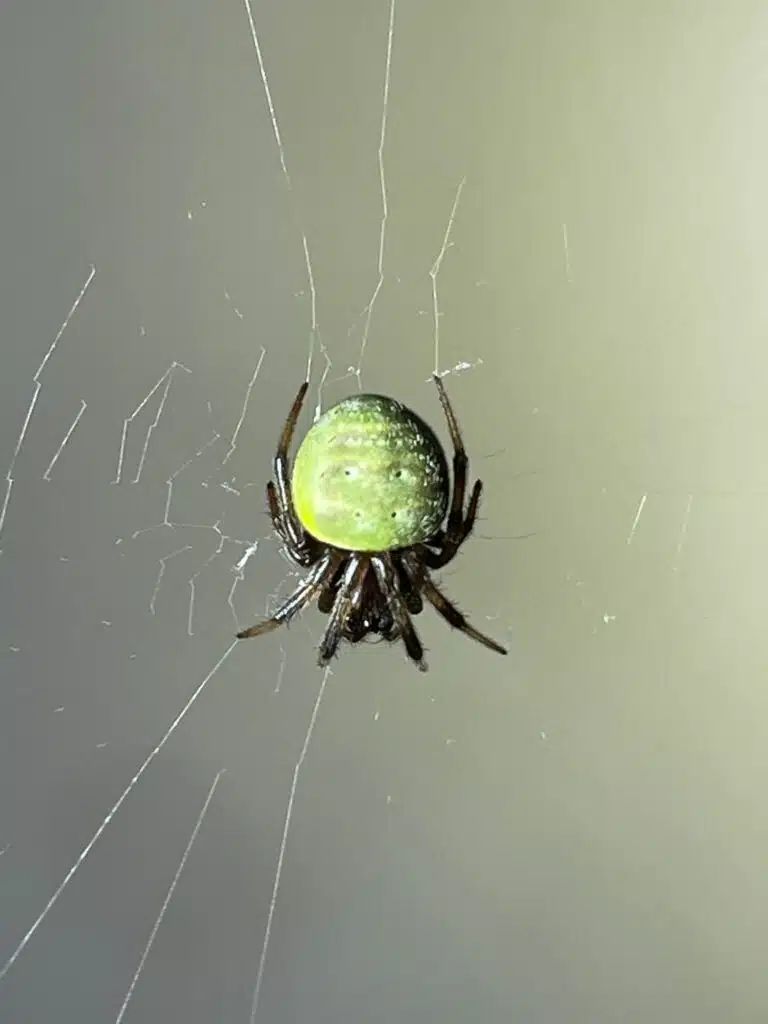
Scientific name: Araneus apricus
Common name: Green-pea spider
The Greeen-pea spider gets its name from its vivid green abdomen contrasted by the brown-red cephalothorax and by its brown-red legs.
Green-pea spiders have a vivid green abdomen with 5 small dark spots and multiple smaller faded yellow spots.
The rest of the body has a dark contrasting color which means it aids the camouflage aspect of the species.
Native to South Africa, the Green-pea spider isn’t easily observed as it hides in or under leaves.
This species is nocturnal preferring to rest during the day.
26. Green-legged Orbweaver
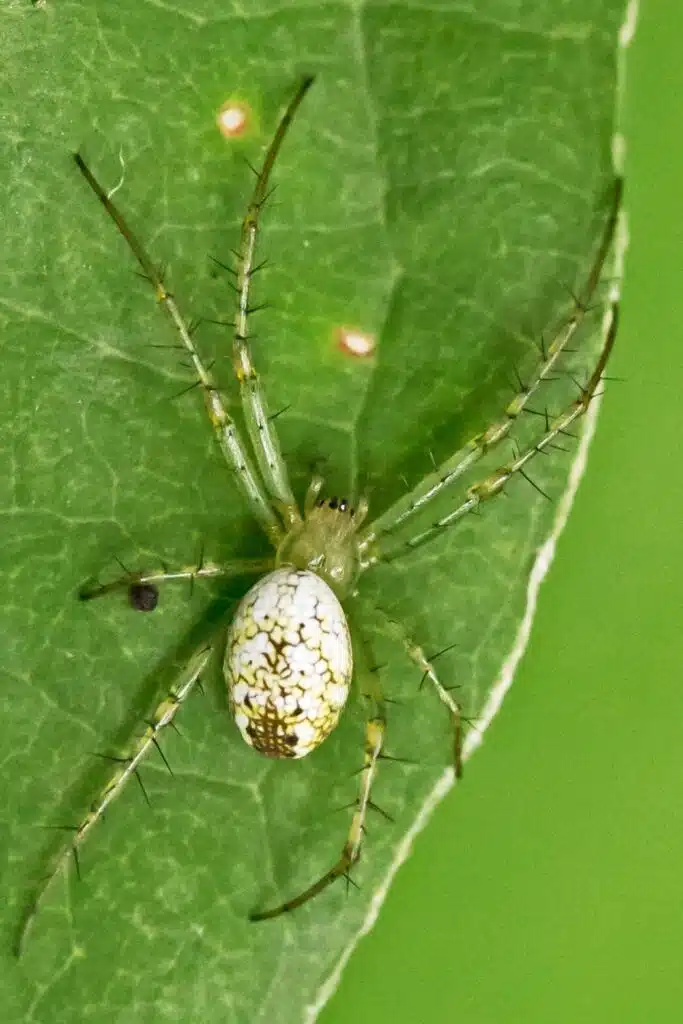
Scientific name: Mangora maculata
Common name: Green-legged orbweaver
Green-legged Orbweavers are one of the multiple green orbweavers.
Spiders of this genus have green legs with black hairs and a white bulbous abdomen.
The white abdomen has dark green or dark brown marks making it resemble a small piece of marble.
Commonly found in the US, the Green-legged Orbweaver is also found in other colors. Most other morphs are only different on the abdomen.
Most Green-legged Orbweavers have a green cephalothorax and a vividly-colored abdomen.
The variations of the abdomen coloring include brown and white, brown-yellow and white, and yellow, white, and brown.
The colors of the abdomen are often adaptations of the Green-legged Orbweaver to the host plant.
27. Diaea livens
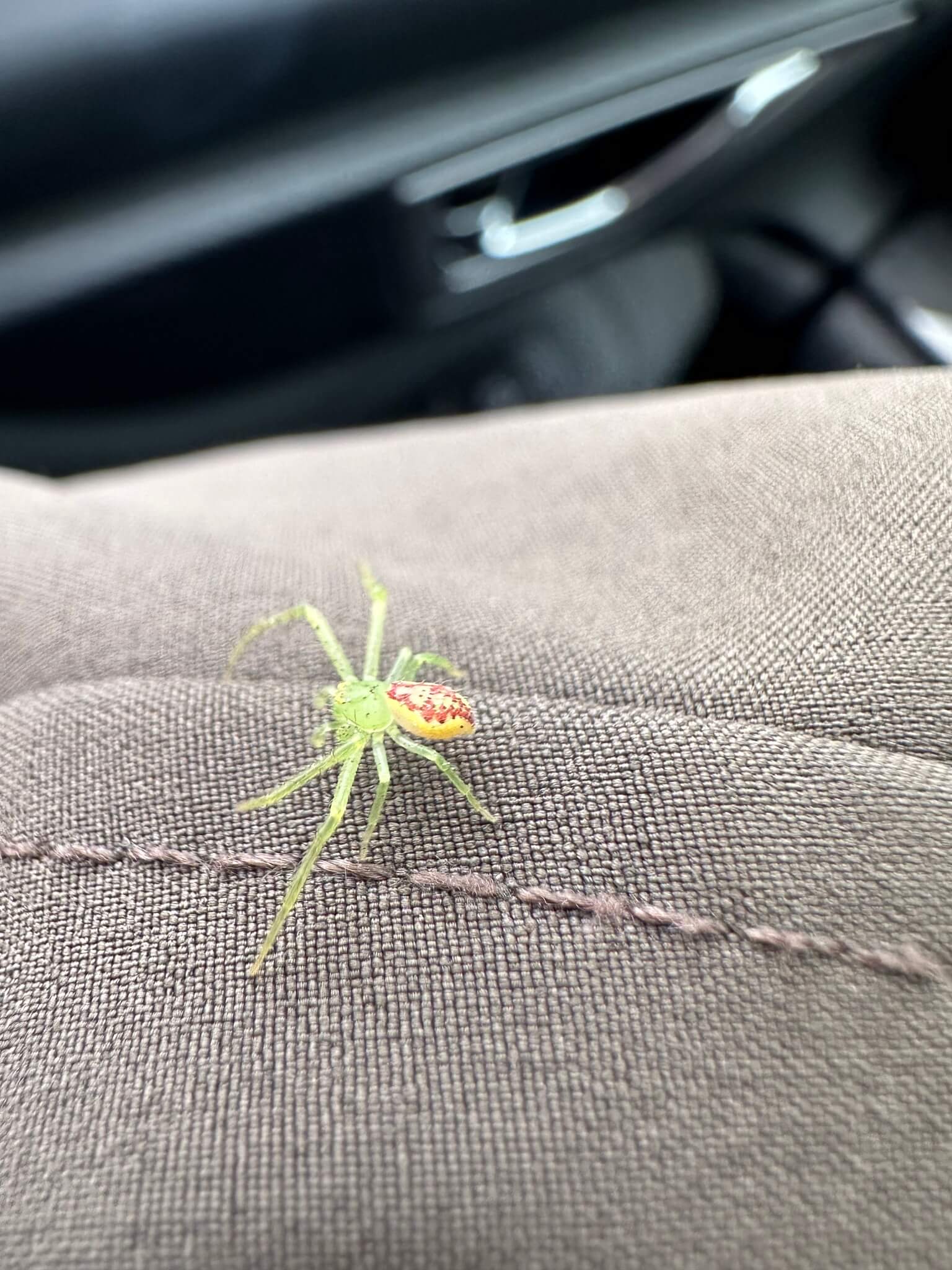
Scientific name: Diaea livens
Common name: Diaea livens
This species is common in Europe and California. It lives in woodlands next to coastal areas and it’s seen in green color or brown color.
The green coloring of the species comes with green legs but a contrasting off-white abdomen.
Spiders of this species can show multiple red or black dots across their bodies.
28. Okinawa’s Green Crab Spider
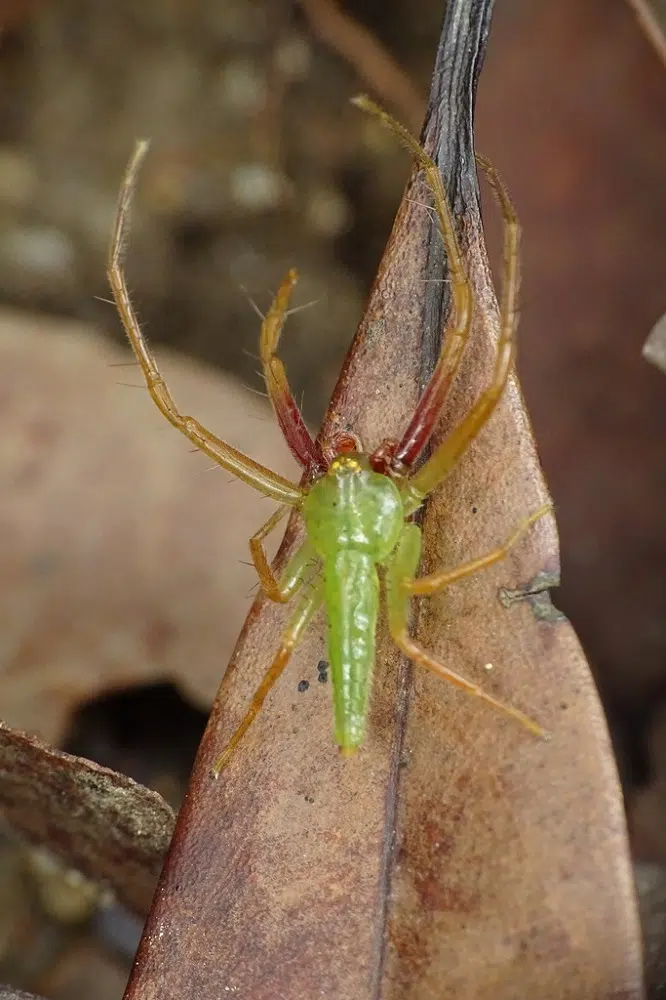
Scientific name: Oxytate hoshizuna
Common name: Okinawa’s green crab spider
These green spiders are common in Asia, Europe, and South Africa with an expanding range across the world.
Spiders of this genus do not build spider webs even if they could produce silk. They prefer to ambush insects making the most of their uniform camouflage green color.
This family of spiders is known for reflecting UV lights with its translucent body.
It’s believed their capacity to reflect light is a major advantage when it comes to guiding bees to flower or attracting more bees to a certain flower.
29. Tiny Green Huntsman Spider
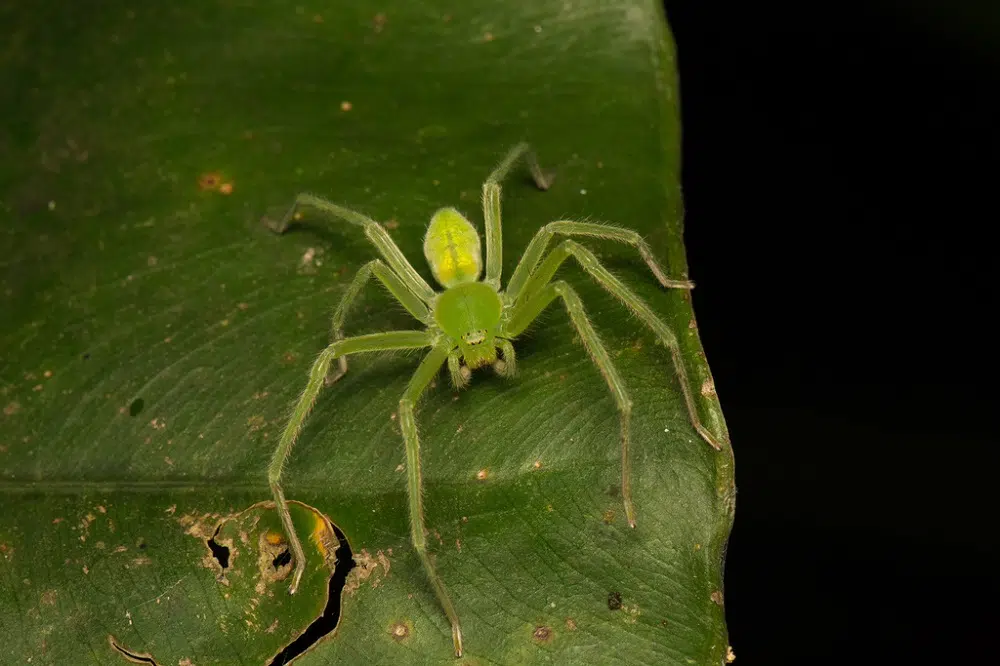
Scientific name: Gnathopalystes taiwanensis
Common name: Tiny green huntsman spider
The Tiny Green Huntsman spider might not consume prey as large as other Huntsman spiders but it’s still very common in tropical regions of the world.
Spiders of this species are known for having uniform green coloring with a slightly brighter green color abdomen.
They are found on leaves where they eat insects both during the day and during the night.
30. Kidney Garden Spider
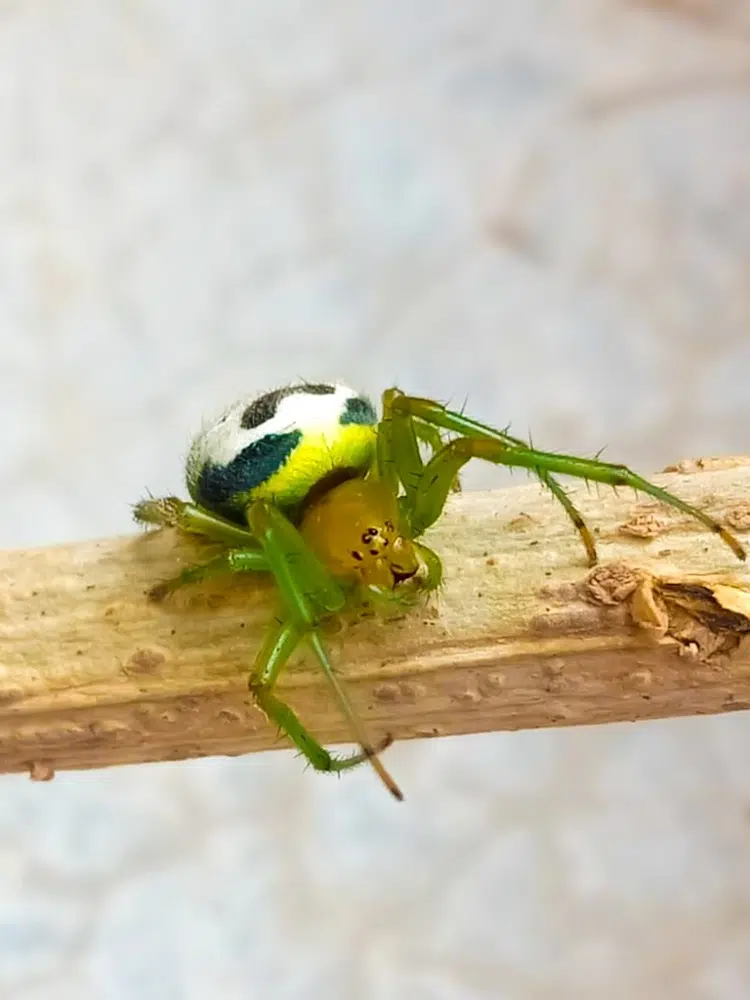
Scientific name: Bijoaraneus mitificus
Common name: Kidney Garden Spider
Kidney Garden spiders are known for building small spider webs inside curled leaves.
Spiders of this genus are also known for their vivid green coloring.
They have a green cephalothorax and a white globular-shaped abdomen.
Kidney Garden spiders are similar in size to the Tiny Green Huntsman spider as they grow to a maximum size between 3 and 5mm.
Further Reading: